News
Search results for the keyword [Hangzhou]:
2024. 8. 29
-
Hangzhou Botanical Garden showcases stunning lycoris flower bloom
20:09 Author:en.hangzhou.com.cnThe Hangzhou Botanical Garden has recently become a hotspot for visitors, with its lycoris flowers, known as the Chinese tulip, having entered their peak blooming season. The garden is now a vibrant sea of red, yellow, and pink, attracting many visitors eager to capture the breathtaking scene.
Lycoris, also known as spider lily or equinox lily, is a perennial plant that blooms between summer and autumn. The flowers are unique for their striking appearance and the fact that they bloom without leaves, which has earned them the poetic name "flowers from the other shore".
According to Zhang Pengchong, a senior engineer at the garden, this year's bloom is particularly spectacular due to the overlap of early, mid, and late-blooming varieties, resulting in one of the best displays in recent years.
Visitors looking to admire the lycoris blooms can enter through the garden's south gate and follow the main path. The flowers can be seen in several areas, including the Economic Plant Zone, Plant Classification Zone, and the Baicao Garden, as well as along the roadsides near the south and north gates.
Original link
2024. 8. 28
-
Liangzhu Cultural Corridor initiative makes progress
19:54 Author:en.hangzhou.com.cnThe Liangzhu Cultural Corridor, an initiative that Yuhang district, Hangzhou launched to promote Liangzhu culture, a prehistoric rice-cultivating civilization that existed between 3300 BC and 2300 BC in China, has witnessed remarkable progress as exemplary projects are carried out.
A surge of tourists flocked to the recent market event at the Liangzhu 5000+ Artistic Creation Park, one of the initial 10 projects in the Liangzhu Cultural Corridor initiative. The park has welcomed 120,000 visitors since its opening on July 12, solidifying its status as a new landmark along this cultural corridor.
Following the inscription of the Archaeological Ruins of Liangzhu City onto the World Heritage List in 2019, Yuhang district embarked on an exploration of the "second chapter" of Liangzhu culture by launching the Liangzhu Cultural Corridor initiative, which focuses on cultural empowerment and integrates historical preservation, economic development, industrial transformation and shared prosperity.
With a series of flagship projects currently underway, Yuhang is leveraging the 5,000-year-old Liangzhu culture as a guiding force for socioeconomic growth. By connecting it with regional cultures such as Grand Canal culture, Jingshan culture, ancient towns and modern digital culture, the district is ushering in a new era of cultural prosperity to drive comprehensive urban development.
The ongoing reforms and innovations within the Liangzhu Cultural Corridor demonstrate a multi-faceted approach towards the protection of cultural heritage, regional integration, and industrial transformation. Yuhang's commitment to balancing historical preservation with economic and social development exemplifies a harmonious synergy between honoring history and moving forward, showcasing a vibrant model for modernization unique to Yuhang.
Original link
-
Flexible 7-day high-speed rail pass launched for tourists in YRD region
19:51 Author:en.hangzhou.com.cnChina Railway Shanghai Group introduced three new high-speed rail passes designed to meet travelers' diverse travel needs on Aug 26. These passes offer tourists the convenience of "one purchase, three destinations, valid for seven days", providing a flexible and cost-effective way to explore three different cities.
The passes cover popular routes such as Shanghai-Dongtai-Yangzhou, Hangzhou-Qiandao Lake-Yellow Mountain, and Nanjing-Huai'an-Yancheng. Travelers can easily book tickets via the 12306 app or website, or at ticket machines, and use their ID to board any eligible train within the seven-day period.
For example, the Hangzhou-Qiandao Lake-Yellow Mountain pass costs 210 yuan ($29.5), significantly cheaper than buying individual tickets along the same routes.
These passes, with flexible booking and refund options, aim to enhance the travel experience, catering to the growing trend of leisurely tourism in the region.
Original link
-
Hangzhou gears up to become drone sports capital
19:42 Author:en.hangzhou.com.cnHangzhou is accelerating efforts to lead the nation's low-altitude economy, with a focus on drone sports. Following the launch of the Low-Altitude Economy Development Plan (2024-27), the city aims to establish itself as a hub for drone sports in China.
Drone sports, encompassing activities like drone racing, acrobatics, and aerial photography competitions, have garnered increasing attention due to their blend of education and technology. According to Shao Ying, executive director of the Hangzhou Smart City Research Institute, this push aligns with Hangzhou's vision of becoming an international sports city in the post-Asian Games era.
As one of the first cities designated as a national test zone for civilian drones, Hangzhou has developed an innovative ecosystem with companies like Xizi Spirit Aerosystems and Antwork Technology leading the way. The city's universities and research institutions are also at the forefront of efforts to develop electric vertical take-off and landing (eVTOL) technology.
To achieve its goal, Hangzhou plans to integrate drone sports into its broader sports development strategy, provide financial incentives, and attract top international talent. The upcoming World Drone Racing Championships in October will further solidify Hangzhou's global position in drone sports, with 200 competitors from 40 countries expected to participate.
Original link
-
World-class tennis stars to compete in Hangzhou Open
19:33 Author:en.hangzhou.com.cnThe 2024 Hangzhou Open (ATP 250) is set to take place from Sept 17 to 24 at the Hangzhou Olympic Tennis Center. Tennis fans can expect an exciting lineup of nearly 60 top players from around the world.
Leading the roster are big names such as Andrey Rublev, ranked sixth globally and a two-time ATP 1000 Masters champion, and Zhang Zhizhen, Hangzhou Asian Games singles champion and Paris Olympics mixed doubles silver medalist. Other notable stars include Holger Rune, ATP 1000 Paris Masters champion, and Wu Yibing, the first Chinese mainland player to win an ATP Tour title.
Recent additions to the tournament include Sebastian Korda, who just won the ATP 500 Washington Open, and Karen Khachanov, a Grand Slam quarterfinalist. Former world No. 3 Marin Cilic will also make his return after a knee injury.
The event will feature a week of thrilling matches, with ticket prices ranging from 50 yuan ($7) to 1,280 yuan, allowing fans to enjoy multiple matches with a single ticket.
Original link
-
Restored 4K version of China’s first animated feature premieres in Hangzhou
19:30 Author:en.hangzhou.com.cnThe 4K restored version of Princess Iron Fan, China's first animated feature film, premiered at the China Cartoon & Animation Museum in Hangzhou on Aug 24. Prior to the screening, Yang Chenxi, a professor at the China Academy of Art's Film School, provided an introduction to the film.
Directed by the Wan brothers, Wan Laiming and Wan Guchan, Princess Iron Fan was originally released in 1941 in Shanghai. It is a milestone in both Chinese and Asian animation, drawing inspiration from the classic Chinese novel Journey to the West. The film skillfully integrates elements of Chinese painting, opera, and traditional performance arts, while also incorporating Disney-style animation techniques. The film was well-received across Southeast Asia and Japan, where it significantly influenced the famous manga artist and Astro Boy creator, Osamu Tezuka.
The screening was accompanied by a dedicated exhibition at the museum, showcasing historical materials and interactive experiences related to the film and allowing visitors to relive iconic scenes and feel the legacy of China's pioneering animation.
Original link
-
From classrooms to boardrooms
19:24 Author:en.hangzhou.com.cnUniversities in Hong Kong and on the Chinese mainland have become venture capital players, adding teeth to their investments and driving the commercialization of technology and innovation breakthroughs. Li Xiaoyun reports from Hong Kong.
Blackstone - the world's largest alternative asset manager - was grappling with a surge in redemption demands in its real-estate income trust in the fourth quarter of 2022 as investors fretted about the global economic outlook. The turmoil took a heavy toll on the asset management giant's share price, sending it into a nosedive of nearly 20 percent in December that year to its lowest level since April 2021.
However, the company's fortunes took a turn for the better early last year when UC Investments, which manages the University of California's investment portfolio of $169 billion, vowed to sink $4 billion into the trust. It drove Blackstone's share price up more than 6 percent to $82.40 in the two trading days following the decision.
UC Investments' move reflects a growing trend among the world's top tertiary education institutions of not only being active in scientific research, but also playing the role of an investor, often generating returns that exceed the market average. University-managed investments generally comprise retirement, endowment, and cash assets.
In the 2023-24 fiscal year, UC Investments' endowment pool saw an investment return of 8.2 percent, while that of Harvard University, managed by Harvard Management Co, recorded an average annual return of about 11 percent. The revenue from investments contributed more than one-third of Harvard University's annual operating budget.
Universities as VC investors
Blackstone got the ball rolling. Eyeing the potential for financial gain and enhanced social impact, universities in the Hong Kong Special Administrative Region and on the Chinese mainland have also diversified their roles as venture capital players. These institution-backed funds focus mainly on innovation and technology projects started by university professors, students or alumni.
The University of Hong Kong recently made an ambitious foray into the field by investing 70 million yuan ($9.8 million) in a mainland fund rather than a specific project. Industry insiders say the move is to expand the university's investment reach beyond the campus.
Distinct from universities' traditional approach of investing directly in promising projects, they function as limited partners that provide funding to venture capital managed by general partners who select appropriate investment projects. Industry insiders say such a model can enhance the professionalism and objectivity of universities' investment decisions. It also directs more social capital to initial projects with university endorsements, facilitating the commercialization of technology breakthroughs, and invigorating Hong Kong's innovation and technology ecosystem.
The Hong Kong University of Science and Technology said in April it would spend HK$500 million ($64 million) on setting up a Redbird Innovation Fund. In collaboration with investment partners, the fund is expected to be gradually increased to HK$2 billion.
HKUST will function as a pipeline linking startups and investors, but the decision on what to invest in will be made by general partners, explains Kim Shin Cheul, the university's associate vice-president for research and development (knowledge transfer). "We will leave the decision making to market experts who know investment business better than we do."
Funding crunch
Universities are generally motivated by internal and external factors when dipping their toes into the venture capital business. Internally, the burgeoning startup ecosystem within universities is fueling a growing demand for capital. HKUST had more than 1,800 active startups as of June, while the City University of Hong Kong has surpassed its goal of incubating 300 startups within three years.
Externally, profit-driven venture capital funds are increasingly reluctant to risk investing in projects in their infancy as they typically lack a product prototype or a fully fledged team. Government support, while crucial, often falls short of meeting the funding needs of startups.
The HKSAR government launched its Technology Start-up Support Scheme for Universities in 2014, providing financial aid for budding enterprises at six local institutions of higher learning. The program accelerated in the 2023-24 fiscal year with each university now eligible for up to HK$16 million in funding annually. Each startup can receive up to HK$1.5 million yearly for a maximum of three years.
Taking things a step further, the government started the Research, Academic and Industry Sectors One-plus Scheme in October last year to promote the commercialization of research outcomes. The program will provide funding of not more than HK$100 million to at least 100 university-cultivated research teams with the potential to become startups.
Despite the efforts, such financial assistance is a far cry from what startups need, especially those engaging in sectors with a long R&D cycle and large capital consumption.
Take the life sciences sector, to which the government is giving priority, for instance. The average research and development cost of developing a drug by the world's 20 largest pharmaceutical companies remains staggeringly high at $2.3 billion, suggesting that startups in this industry require access to a diverse range of funding sources beyond just government financing.
Under the current economic climate, private investors are becoming more cautious. According to a report by audit services provider KPMG, global venture capital investments declined by more than one-third on a yearly basis in 2023, with the number of deals dropping from 51,894 to 37,808. KMPG blamed geopolitical tensions, high interest rates, inflation and a sluggish initial public offering market for the downturn.
Ivan Shum, founding chairman of Angel Investment Foundation, notes that venture capital funds are losing enthusiasm for long-term investments. "Instead of nurturing companies all the way to an IPO, investors are increasingly eager to see quick returns on their investment."
Quest for tech transfer
However, universities view it in a different way. "While most startups fail, the experience gained by young entrepreneurs is invaluable, thus accelerating their growth in the future," says Michael Yang Mengsu, senior vice-president (innovation and enterprise) at CityU.
Under pressure internally and externally, the emergence of university-backed funds can take on even greater significance, Shum notes, saying he believes that universities' involvement can attract more co-investors, diversify risks and inject fresh energy into the dampened venture capital market.
Samson Tam Wai-ho, a partner of Hong Kong Inno Angel Fund, agrees, pointing out that tech startups are capital-intensive and often yield returns over a long period. Thus, they need sustained and steady financial support.
Fudan University in Shanghai adopted the same concept when it initiated its innovation and technology fund in December last year. The fund, jointly launched by the university, the Shanghai municipal government, State-owned enterprises and market institutions, is aimed at leveraging Fudan's strengths in various disciplines to guide private investment towards projects that can transform cutting-edge technologies into real-world applications.
Shanghai Deputy Mayor Liu Duo said he hopes the fund will prioritize backing high-risk and early-stage, but high-value projects with hard technologies. This approach aligns with the National Development and Reform Commission's definition of hard technology, which covers artificial intelligence, biotechnology, information technology, new materials, and intelligent manufacturing.
The HKUST's Redbird Innovation Fund also targets these spheres. Kim says they're in line with the university's research strategy and are relevant to current social challenges like aging and climate change.
Samson Tam, who represented the information technology sector in Hong Kong's Legislative Council, sees the universities' move into venture capital as a sign of the city's status in the 3.0 phase of technology commercialization. This phase, he says, is characterized by a collaborative approach, bringing together academia, industries and investors in getting new startups off the ground, based on university-nurtured technologies.
He contrasts this with the earlier 1.0 phase, where universities focused on developing technologies and patenting them, hoping to sell those patents to interested companies. However, many patents have remained unclaimed, Tam notes, citing the example of a nuclear power patent, which would struggle to find a suitable application in Hong Kong's limited market.
The 2.0 phase saw a shift toward a more demand-driven model, with companies taking the lead and universities conducting research based on their needs. The government stepped in as a facilitator, linking companies with universities' research. During this period, the government established five research centers specializing in areas such as logistics, advanced materials, and telecommunications, two of which are run by local universities. Industry experts hold mixed views on the effectiveness of these institutions promoting technology transfer, saying the research might be disconnected from market demand.
But, as nonprofessional investors, universities' role as limited partners in the 3.0 era isn't free of challenges, such as in identifying investment partners and nurturing entrepreneurial professionals.
'Building an ecosystem'
Kim says finding appropriate general partners is one of the make-or-break factors since universities invest in hard tech for the long haul, meaning their partnerships with general partners can last up to a decade. The Redbird Innovation Fund is seeking general partners, with the selection process expected to be completed later this year.
Tam, himself an investor, agrees that finding the right general partner is crucial for universities. "Investing is about building an ecosystem," he says, urging universities to choose partners with a strong "ecosystem" in Hong Kong.
In his view, the "ecosystem" refers to a network of connections and resources, both upstream and downstream, and general partners should know how to help startups link up with other venture capital funds, gain access to local incubators like Cyberport and Science Park, and expand to markets outside Hong Kong where the industry they've chosen is thriving.
For instance, an automotive parts company could benefit from expanding to Guangzhou, capital of Guangdong province, which has been China's top car producer for the past five years, while an internet firm might find success in Hangzhou, Zhejiang province - a hub of the nation's tech giants - and Web3 companies could explore opportunities in Singapore.
Tam believes a healthy entrepreneurial ecosystem also requires professionals who are not just research powerhouses, but also adept at transforming their discoveries into products, and scaling those products to sustainable businesses.
To bridge the gap, CityU created a Master of Science in Venture Creation program, which plans to enroll 30 students this year. The program strives to equip students with the skills needed to start successful ventures through courses like financial and management accounting, people analytics, and social media marketing. Students can graduate with a business plan or a startup project, potentially receiving funding from the university to further develop their ideas, says Yang.
HKUST has introduced a similar program to cultivate a new generation of entrepreneurs who are well-versed in technology commercialization and business governance through collaboration with various schools.
Although Hong Kong is blessed with the financial prowess to develop into a fertile ground for venture capital, becoming a limited partner in the field is still a new experience for the local academia. Seasoned investors see the potential while warning of the hurdles ahead.
Original link
-
Xiaoyuanshui Sports Park to feature year-round immersive experiences
19:18 Author:en.hangzhou.com.cnConstruction began on the Xiaoyuanxi Water Sports Park in Tonglu county, Hangzhou on Aug 22, with an investment of approximately 3.2 billion yuan ($448 million).
Located in a tranquil valley in Sanxin village, the park will integrate advanced AR technology, offering an immersive experience within a water park setting – the first of its kind in the region.
The park will feature a mix of attractions, including a large water park, high-tech visual performances, luxury hotels, and wellness facilities. The design will blend local cultural elements with cutting-edge technology to create a unique destination for both leisure and business travelers.
Scheduled to be completed in phases, the park aims to become a top micro-vacation destination in East China and a national base for immersive performances. Highlights include the country's longest water park lazy river, which is over 2 kilometers long, and the largest wave pool, which covers an area of 21,000 square meters.
Set against the backdrop of a natural mountain valley, the park will offer a year-round experience, adapting its attractions to different seasons and times of day. From winter performance stages to summer water activities, it is expected to draw many tourists and generate substantial revenue for Tonglu.
Original link
-
2024 Hangzhou International Basketball Showdown set for August
19:15 Author:en.hangzhou.com.cnThe 2024 Hangzhou Qianjiang Century City International Basketball Showdown will be held from Aug 31 to Sept 2 at the Hangzhou Olympic Sports Center.
The highlight of the event is expected to be Europe's powerhouse, FC Barcelona's basketball team, featuring former NBA stars like Juancho Hernangomez, Tomas Satoransky, and Jabari Parker. This marks their first pre-season game in China.
Two CBA teams, Zhejiang Guangsha and Beijing Shougang, will also compete, bringing excitement for Chinese basketball fans.
Tickets are available on Damai are being bought up by both domestic and international basketball communities.
Original link
-
Hangzhou ice hockey event reaches record scale with nearly 300 young participants
19:13 Author:en.hangzhou.com.cnAs the summer heat subsides, winter sports are heating up in Hangzhou. The first Hangzhou Ice Hockey Festival and "MixC Cup" 2024 National Ice Hockey Championship kicked off on Aug 22 at the Hangzhou MixC shopping mall, running until Aug 25.
This event has attracted top clubs from across China, including Beijing, Shanghai, Hangzhou, and Chengdu. Nearly 30 teams, competing across four divisions, will compete in nearly 60 matches. With around 300 young players involved, this event marks a record for Hangzhou ice hockey, promoting the integration of ice hockey education and competition while building a strong talent pool for the sport's growth in Zhejiang.
Hosted in a bustling commercial area, the event offers spectators a chance to enjoy competitive ice hockey up close while raising the sport's profile and boosting public interest. The Qianjiang New City business district will also host cultural activities to further promote the sport to the local community.
Original link
2024. 8. 27
-
Huzhou-Hangzhou Expressway to start operation in September
18:52 Author:en.hangzhou.com.cnRecently, Wuxing-Deqing Section of Huzhou-Hangzhou Expressway has passed the acceptance. It is expected to be open to traffic by the end of September.
After opening, Huzhou will add a new expressway leading to Hangzhou in the east. The residents of Zhili, Jiuguan, Linghu, Qianjin and other towns/townships in the east region of Huzhou can reach the expressway within 15 minutes.
This expressway is connected to multiple expressways between Hangzhou and Huzhou, which helps to alleviate traffic pressure of existing routes, and boosts the coordinated economic development between two regions.
Original link
2024. 8. 23
-
Children have fun while learning about science
11:34 Author:Shanghai Daily ShineTi Gong Children enjoy the "The Gone Dr. K" racing game. A summer science camp kicked off today at Pudong Library, mixing educational talks with interactive fun to explore science. The "Fun with Science – Summer Weekend Camp" is organized by the library, Shanghai Science and Technology Museum, and the Shanghai Science Popularization Education Development Foundation. A highlight was a captivating lecture by Fang Jiancheng, an academician from the Chinese Academy of Sciences. His talk – "Exploring the Scientific World in Extremely Weak Magnetic Environments" – explained the basics of very weak magnetic fields and introduced the Hangzhou Extremely Weak Magnetic Field Major Science and Technology Infrastructure. This facility aims to advance scientific knowledge with highly sensitive measurement tools, supporting research in areas such as neuroscience, brain science, physics, zero-magnetic biology, and medicine.
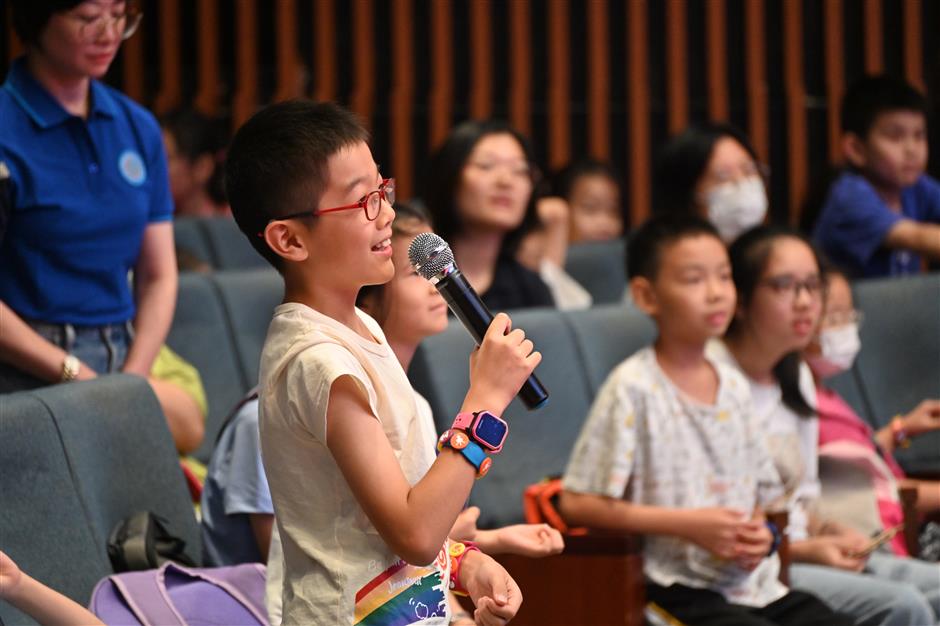 Ti Gong
A boy asks question after the lecture.
Another feature of the camp was the launch of "The Gone Dr. K" racing game.
Developed by the science and technology museum, the interactive game uses a digital twin of the museum's main exhibition areas. Since its release in June, the game has allowed players to navigate a 1:1 replica of the museum and solve complex puzzles.
During the event, 20 teams raced through the digital museum world with their virtual avatars, tackling 20 challenging puzzles in 150 minutes.
The "Curiosity Market," an additional attraction, showcased a variety of interactive exhibits, such as robotic dogs, game-playing robots, and immersive mixed reality games.
The camp's blend of high-caliber lectures and hands-on activities reflects a growing trend to make science accessible and engaging for all ages.
Ti Gong
A boy asks question after the lecture.
Another feature of the camp was the launch of "The Gone Dr. K" racing game.
Developed by the science and technology museum, the interactive game uses a digital twin of the museum's main exhibition areas. Since its release in June, the game has allowed players to navigate a 1:1 replica of the museum and solve complex puzzles.
During the event, 20 teams raced through the digital museum world with their virtual avatars, tackling 20 challenging puzzles in 150 minutes.
The "Curiosity Market," an additional attraction, showcased a variety of interactive exhibits, such as robotic dogs, game-playing robots, and immersive mixed reality games.
The camp's blend of high-caliber lectures and hands-on activities reflects a growing trend to make science accessible and engaging for all ages.
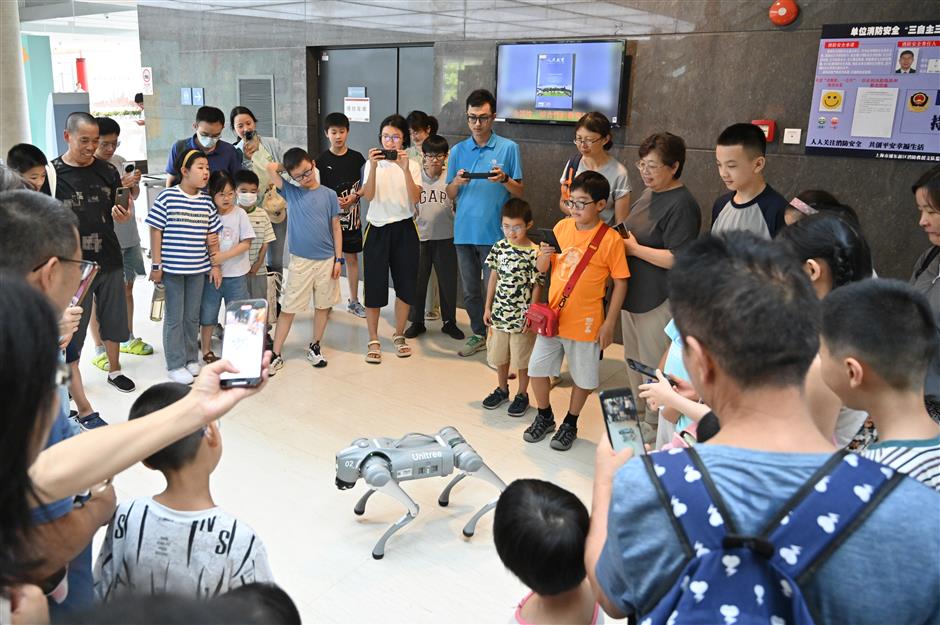 Ti Gong
A robot dog entertains the crowd.Original link
Ti Gong
A robot dog entertains the crowd.Original link
-
Preview of 3rd GDTE’s highlights
10:09 Author:en.hangzhou.com.cnThe third Global Digital Trade Expo (GDTE) will be held in Hangzhou on September 25-29. The expo will span 150,000 square meters, featuring a comprehensive pavilion and eight specialized pavilions dedicated to various digital industries. The first robot exhibition area will be seen and the Global Smart City Conference is set to be held then at the event.
More than 1,000 digital trade enterprises and 15 international organizations have confirmed their participation, and professional purchasers from over 50 countries and regions are expected to join in the procurement activities.
Activities such as Silk Road E-commerce Day and Digital Trade Night will be held, and interactive experiences will be enhanced through technologies like digital human, blockchain, artificial intelligence, and glasses-free 3D.
It will optimize the online platform called "Digital Trade Online" to extend trading time from five days offline to 365 days a year online.
GDTE's registration channel for merchants opens
The third Global Digital Trade Expo (GDTE) will be hosted at Hangzhou Grand Convention and Exhibition Center on September 25-29, 2024.
At present, the registration channel for merchants has been opened. Please scan the QR code for details:

Registration code for merchants
Original link
-
Astonishing tide of Hangzhou’s Qiantang River staged
09:54 Author:en.hangzhou.com.cn
On the 18th day of the seventh lunar month (August 21), the annual “Ghost King Tide” of Qiantang River was staged, attracting numerous tourists.

Ghost King Tide [ Photo by Fan Fangbin]
The best time to watch the tide is the 18th day of the eighth lunar month. Due to the differences in terrain, the tides have various postures, such as "one-line bore" and "cross bore".

One-line bore [Photo/People's Daily Zhejiang Daily]

Double-color cross bore [Photo/Beautiful Zhejiang]
Original link
-
In pics: Movable feast at Grand Canal in Hangzhou
09:49 Author:en.hangzhou.com.cnThe Grand Canal in Hangzhou is a tourist route that combines historical & cultural deposits with modern life atmosphere. Tourists can take a water bus with the ticket price of 3 yuan to enjoy the wonderful scenery along the canal, and explore nearby attractions.
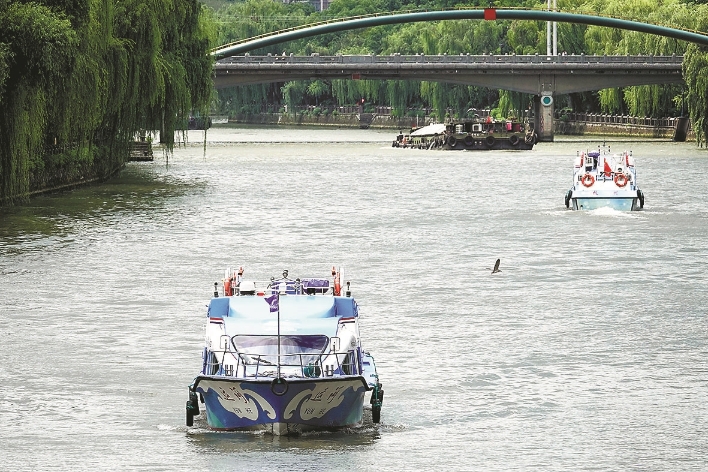
Water bus on the Canal [Photo by Fa Xin, Li Zhong]
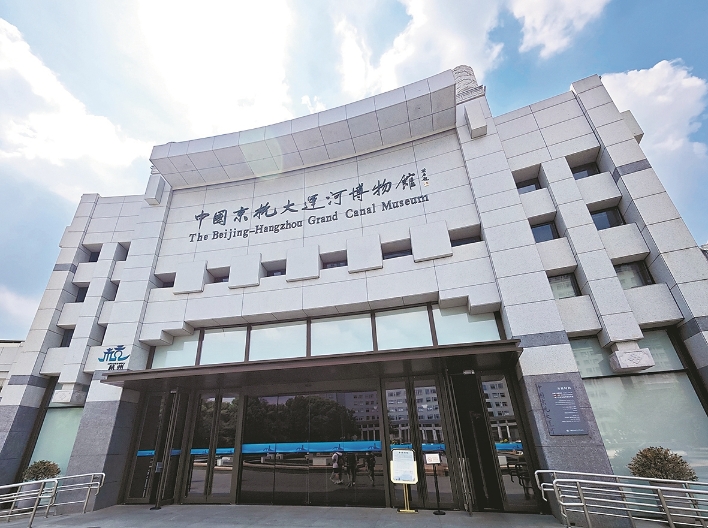
The Beijing-Hangzhou Grand Canal Museum with rich historical culture [Photo by Fa Xin, Li Zhong]

Bustling Qiaoxi Historical & Cultural Street [Photo by Fa Xin, Li Zhong]
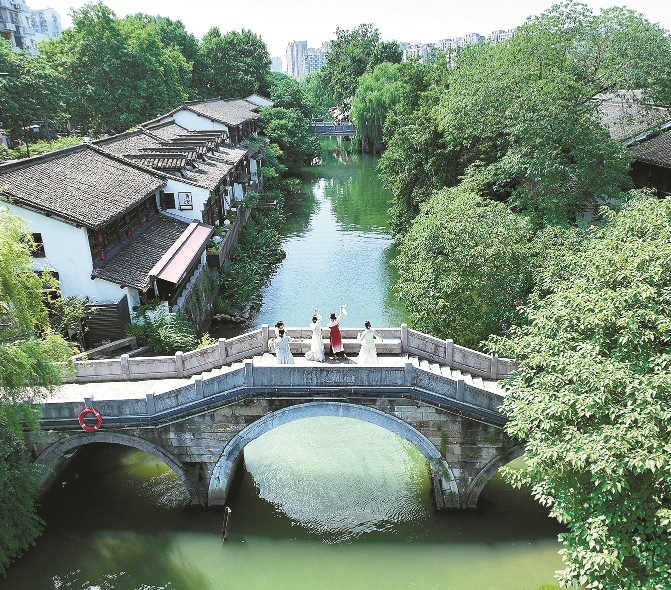
Xiaohezhi Street, a popular spot for taking photos [Photo by Fa Xin, Li Zhong]
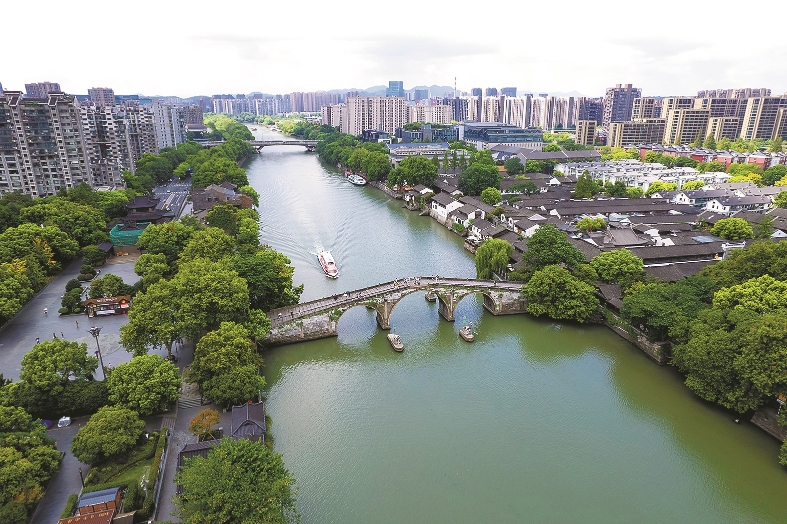
Gongchen Bridge with beautiful scenery [Photo by Fa Xin, Li Zhong]
Original link
-
3rd Global Digital Trade Expo to boost global digital trade cooperation
09:43 Author:en.hangzhou.com.cnHANGZHOU - The third Global Digital Trade Expo will take place in Hangzhou, capital of East China's Zhejiang province, from Sep 25 to 29, featuring Kazakhstan and Thailand as guests of honor.
The expo aims to leverage global digital trade resources to enhance cooperation and promote development, said Deng Bo, deputy director of the Trade Development Bureau of the Ministry of Commerce, at a press conference on Wednesday.
According to Han Jie, director of the Department of Commerce of Zhejiang province, more than 1,000 digital trade enterprises and 15 international organizations have confirmed their participation, and professional purchasers from over 50 countries and regions are expected to join in the procurement activities.
The expo will span 150,000 square meters, featuring a comprehensive exhibition area and eight specialized zones dedicated to various digital industries.
Industrial activities related to artificial intelligence, low-altitude economy and digital healthcare will be included in the expo.
Launched in 2022, the annual event is co-hosted by the government of Zhejiang province and China's Ministry of Commerce.
Original link
2024. 8. 22
-
Requirements for Foreign Nationals to Apply for 144-Hour Visa-Free Transit in China
12:30 Author:Wuhan News
The National Immigration Administration (NIA) has announced that the airport of Zhengzhou has implemented the 144-hour visa-free transit policy. The permitted stay area for foreign nationals entering China through this airport is the administrative region of Henan Province. Eight additional permitted stay areas (including cities and autonomous prefectures) for foreign nationals entering Yunnan Province under the 144-hour visa-free transit policy have also been designated in addition to Kunming, namely Lijiang, Yuxi, Pu'er, Chuxiong, Dali, Xishuangbanna, Honghe and Wenshan. This time, three exit-entry ports, namely Zhengzhou Xinzheng International Airport in Henan Province, and Lijiang Sanyi International Airport and the exit-entry port of Mohan Railway Station in Yunnan Province, have been designated to implement the 144-hour visa-free transit policy. All the aforementioned changes have been effective July 15.
It is reported that, so far, NIA has implemented the 144-hour visa-free transit policy at 37 exit-entry ports in Beijing Municipality, Tianjin Municipality, Shijiazhuang and Qinhuangdao (Hebei Province), Shenyang and Dalian (Liaoning Province), Shanghai Municipality, Nanjing and Lianyungang (Jiangsu Province), Hangzhou, Ningbo, Wenzhou and Zhoushan (Zhejiang Province), Zhengzhou (Henan Province), Guangzhou, Shenzhen and Jieyang (Guangdong Province), Qingdao (Shandong Province), Chongqing Municipality, Chengdu (Sichuan Province), Xi'an (Shaanxi Province), Xiamen (Fujian Province), Wuhan (Hubei Province), Kunming, Lijiang and Xishuangbanna (Yunnan Province), etc. Citizens of 54 countries (including the United States, Canada, the United Kingdom, etc.), who hold valid international travel documents and confirmed connecting tickets for flights, trains and ships departing for third countries within 144 hours after having arrived in China, are eligible to transit through any of the 37 aforementioned ports without visas. Within their stay periods, they can travel, engage in business activities, visit their friends and relatives, and engage in other short-term activities (subject to the relevant provisions if applicable to a mutual visa exemption agreements signed with China or China’s unilateral visa exemption).
According to an official of NIA, the 72/144-hour visa-free transit policies effective in January 2013 are of great importance in China's high-level opening-up, facilitated personnel exchanges between China and other countries and regions, and promoted broader cooperation. The latest expansion of the scope of the 144-hour visa-free transit policy, which involves two provinces, will provide more options for foreign nationals to travel and trade in China. Moving forward, NIA will continue to optimize the extant visa-free transit policies and intensify the institutional opening-up of immigration management. NIA also aims to welcome more foreign nationals to China with a more inclusive gesture and contribute to the greater opening-up and high-quality development of China.
Editor: Nie Yang
Original link
2024. 8. 21
-
Booming passenger and freight transport at Hangzhou Intl Airport (Jan-Jul)
20:16 Author:en.hangzhou.com.cnFrom January to July, Hangzhou International Airport saw a surge in passenger traffic, with over 2.72 million travelers, marking a 118.21% increase year-over-year. Foreign passengers numbered nearly 179,000, up over 152%. Visa-free arrivals increased 4.2 times compared to the same period last year, primarily from Malaysia, Singapore, Thailand, and Italy. The airport also reported strong cargo performance, with a total import and export value of 34.44 billion yuan, up 27.2% year-over-year. Its route network continues to expand, serving major global economies with 32 passenger destinations and 16 cargo destinations.Author: Text by Ye Lijiao Editor: Ye LijiaoOriginal link
-
New landmark to be seen at Hangzhouxi Railway Station
20:12 Author:en.hangzhou.com.cnBuilding D of the South Station-City Complex at Hangzhou West Station has recently been completed. This project comprises"Cloud Gate" and four skyscrapers, known as the "Golden Finger" Tower A, along with Towers B, C, and D, forming a landmark cluster for Hangzhouxi Railway Station.
The complex, scheduled for completion in 2028, will integrate high-end offices, hotels, commercial spaces, apartments, and supporting facilities.
Original link
-
China-made Monkey King video game causes a frenzy on global debut
10:05 Author:Shanghai Daily ShineBlack Myth: Wukong created a frenzy after its global debut on Tuesday with players and brands attending game-play events nationwide. Black Myth: Wukong, the first Chinese-made AAA game, created a frenzy on its global debut on Tuesday. The action role-playing game of the Money King Wukong, based on the Chinese legend "Journey to the West," could be a milestone in gaming history to boost the domestic gaming market and the digital economy. It highlights the growing influence of Chinese game developers on the international stage and the potential of Chinese culture to captivate a global audience.
 Ti Gong
A screenshot of the game.
Black Myth: Wukong, developed by Hangzhou-based Game Science, made its global debut on Tuesday morning on platforms including Steam, PlayStation and Tencent's WeGame, with a starting price of 268 yuan (US$38).
Within hours of its release, it attracted over 1.5 million players and was trending on social media with high rankings on game review platforms.
By 8pm, over 3 million copies have been sold on Steam. With addition sales on other platforms, the total number of copies sold exceeded 4.5 million, totaling over 1.5 billion yuan (US$211 million) in sales.
A number of hands-on events were held on Tuesday with tech vendors of computers, chips and TVs. A co-branded coffee by the game and Luckin sold out.
Ti Gong
A screenshot of the game.
Black Myth: Wukong, developed by Hangzhou-based Game Science, made its global debut on Tuesday morning on platforms including Steam, PlayStation and Tencent's WeGame, with a starting price of 268 yuan (US$38).
Within hours of its release, it attracted over 1.5 million players and was trending on social media with high rankings on game review platforms.
By 8pm, over 3 million copies have been sold on Steam. With addition sales on other platforms, the total number of copies sold exceeded 4.5 million, totaling over 1.5 billion yuan (US$211 million) in sales.
A number of hands-on events were held on Tuesday with tech vendors of computers, chips and TVs. A co-branded coffee by the game and Luckin sold out.
 A co-branded coffee by Wukong and Luckin sold out.
It's a milestone in China-made games, both on completion and average levels, said Xie Zhugong, a media partner and a veteran game fan.
WeChat user Xiao Shen commented: "I am excited that China has finally made its own 3A (game) masterpiece, even better than those from big names like EA, CDPR, and Capcom. It's the game of the year of 2024."
The game's standard of all indicators are top-notch, covering plot, graphics, modeling, systems, combat and music, Shen added.
A co-branded coffee by Wukong and Luckin sold out.
It's a milestone in China-made games, both on completion and average levels, said Xie Zhugong, a media partner and a veteran game fan.
WeChat user Xiao Shen commented: "I am excited that China has finally made its own 3A (game) masterpiece, even better than those from big names like EA, CDPR, and Capcom. It's the game of the year of 2024."
The game's standard of all indicators are top-notch, covering plot, graphics, modeling, systems, combat and music, Shen added.
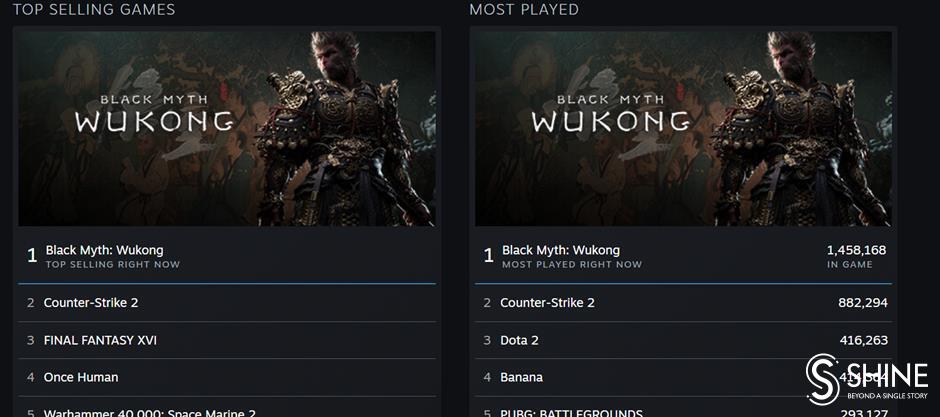 Zhu Shenshen / SHINE
Wukong ranked top on the Steam platform on Tuesday.
Third-party review platforms IGN China and Sina's Gamersky gave the game scores of 10 out of 10. By Tuesday night, the game topped Steam's most played and best selling rankings.
Chinese theme is a hit
The game brings China's story, culture and landscapes to the world stage, with the latest modern technologies.
China's legendary "Journey to the West" stories can be presented in a better and more revitalized way for modern audiences, Feng Ji, founder of Game Science and the game's producer, said in an interview with Xinhua News Agency. The video interview broadcast on Bilibili gained 137,000 likes and was widely spread online.
The development cost of each hour of gameplay of Black Myth: Wukong exceeded 20 million yuan, with the entire development process spanning seven years, enabling movie-quality visuals in both static lighting and dynamic effects, Feng said previously.
In a trial play in Shanghai, several Nvidia GPU computers showcased full ray-tracing effects like realistic water reflections of forests and stones in the game, with cinematic image quality.
According to Nvidia, market leader in AI and graphic computing, players can enjoy the full ray tracing experiences only on GeForce RTX 40 GPUs with DLSS 3 technology.
Zhu Shenshen / SHINE
Wukong ranked top on the Steam platform on Tuesday.
Third-party review platforms IGN China and Sina's Gamersky gave the game scores of 10 out of 10. By Tuesday night, the game topped Steam's most played and best selling rankings.
Chinese theme is a hit
The game brings China's story, culture and landscapes to the world stage, with the latest modern technologies.
China's legendary "Journey to the West" stories can be presented in a better and more revitalized way for modern audiences, Feng Ji, founder of Game Science and the game's producer, said in an interview with Xinhua News Agency. The video interview broadcast on Bilibili gained 137,000 likes and was widely spread online.
The development cost of each hour of gameplay of Black Myth: Wukong exceeded 20 million yuan, with the entire development process spanning seven years, enabling movie-quality visuals in both static lighting and dynamic effects, Feng said previously.
In a trial play in Shanghai, several Nvidia GPU computers showcased full ray-tracing effects like realistic water reflections of forests and stones in the game, with cinematic image quality.
According to Nvidia, market leader in AI and graphic computing, players can enjoy the full ray tracing experiences only on GeForce RTX 40 GPUs with DLSS 3 technology.
 Ti Gong
A sculpture from a Shanxi Temple features in the game.
Game scenes from Chinese landscapes and sites include the Dazu and Anyue Grottoes in Sichun, and temples in Shanxi and Zhejiang provinces. The game also boosted related destination searches such as Datong in Shanxi Province, Trip.com said on Tuesday.
Ti Gong
A sculpture from a Shanxi Temple features in the game.
Game scenes from Chinese landscapes and sites include the Dazu and Anyue Grottoes in Sichun, and temples in Shanxi and Zhejiang provinces. The game also boosted related destination searches such as Datong in Shanxi Province, Trip.com said on Tuesday.
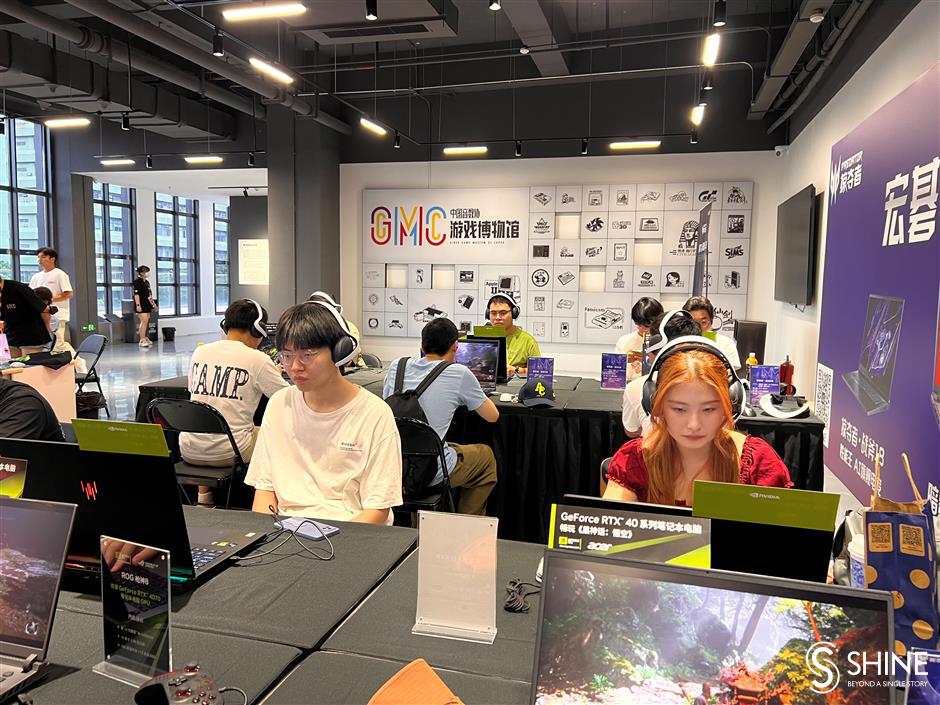 Zhu Shenshen / SHINE
People gather to play the game in a Shanghai game museum in Caohejing.
Hands-on experience in Shanghai
Several game-playing and marketing events were held nationwide, including in Shanghai.
In the new Video Game Museum of Caopa in Shanghai, Black Myth: Wukong featuresd in several game trial playing events held by TV giant Hisense and computer vendor Acer, and in themed products sold in the museum's shops.
More than dozen computers, featuring Nvidia's latest 4090 GPUs, and several Hisesen's TVs, were in use at the site.
Xiaolin, a young machinery designer, tried the game for more than an hour.
"The game scenes and China themes fully meet my expectations," Lin told Shanghai Daily. He said the Wukong game was more difficult than Monster Hunter and Assassin's Creed. He also complained that the voice of small monsters are "too noisy."
The trial will last until Thursday, with online applications required in the game museum's WeChat account.
Zhu Shenshen / SHINE
People gather to play the game in a Shanghai game museum in Caohejing.
Hands-on experience in Shanghai
Several game-playing and marketing events were held nationwide, including in Shanghai.
In the new Video Game Museum of Caopa in Shanghai, Black Myth: Wukong featuresd in several game trial playing events held by TV giant Hisense and computer vendor Acer, and in themed products sold in the museum's shops.
More than dozen computers, featuring Nvidia's latest 4090 GPUs, and several Hisesen's TVs, were in use at the site.
Xiaolin, a young machinery designer, tried the game for more than an hour.
"The game scenes and China themes fully meet my expectations," Lin told Shanghai Daily. He said the Wukong game was more difficult than Monster Hunter and Assassin's Creed. He also complained that the voice of small monsters are "too noisy."
The trial will last until Thursday, with online applications required in the game museum's WeChat account.
 Zhu Shenshen / SHINE
A screenshot showcases the game's realistic effects.Original link
Zhu Shenshen / SHINE
A screenshot showcases the game's realistic effects.Original link


















